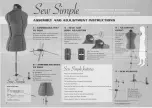
10-3 Disassembling, reassembling and adjusting the feed roller
■
To disassemble the feed roller
1.
Remove screw A on the feed roller presser bar clamp.
Loosen screw B.
2.
Loosen screw D on feed roller bracket C.
3.
Raise the feed roller presser bar as required.
Remove feed roller bracket C.
■
To reassemble and adjust the feed roller
1.
Insert the feed roller presser bar into the feed roller
presser spring, feed roller presser bar clamp and then
feed roller bracket.
2.
Replace screw A of the feed roller presser bar clamp.
Tighten screw A until it contacts the flat spot on the
feed roller presser bar. Tighten screw B.
3.
Create a clearance of approximately 0.1mm between
the feed roller and the needle plate with screw E of the feed roller presser bar clamp
touching the surface of the casting on the machine head. Then tighten screw D.
If the feed roller contacts the needle plate when the machine runs with no fabric, the
feed roller will be worn out. This clearance (0.1mm) prevents the feed roller from
being worn out.
■
Interlock between the feed roller and the presser foot
Pressing the presser foot lift pedal raises simultaneously the presser foot and the feed
roller. The feed roller is factory-set to be raised shortly after the presser foot is raised.
Adjust the timing at which the presser foot and the feed roller are raised according to
sewing conditions. Refer to the procedures below.
1.
Loosen screw D to release the feed roller.
2.
Loosen nut F. Turn adjusting screw E clockwise or counterclockwise as required.
To advance the timing at which the feed roller is raised, turn adjusting screw E
counterclockwise. To delay the timing at which the feed roller is raised, turn
adjusting screw E clockwise.
3.
Lock adjusting screw E with nut E.
4.
Create a clearance of 0.1mm between the feed roller and the needle plate.
Tighten screw D.
【
11
】
ADJUSTING THE STITCH FORMATION
11-1 Needle thread tension
■
Secure needle thread eyelet (left) A in the slot on the
lower part of needle thread eyelet (right) B.
There should be a distance of 20mm from the center of
screw C to the eyes on needle thread eyelet (left) A.
To tighten the needle thread, move needle thread eyelet
(left) A downwards.
19


































